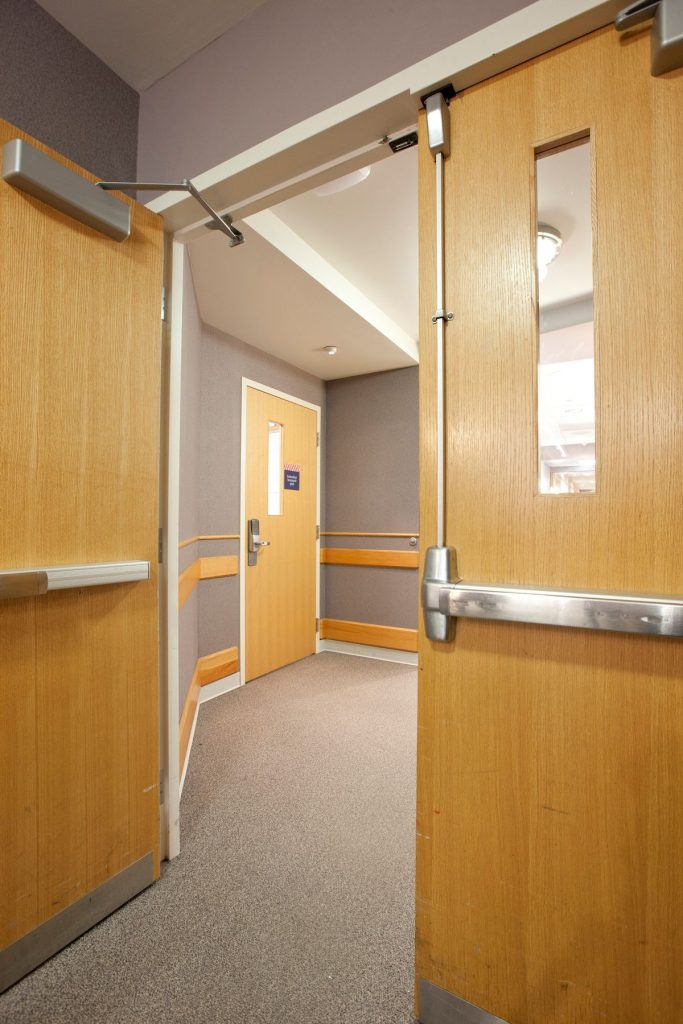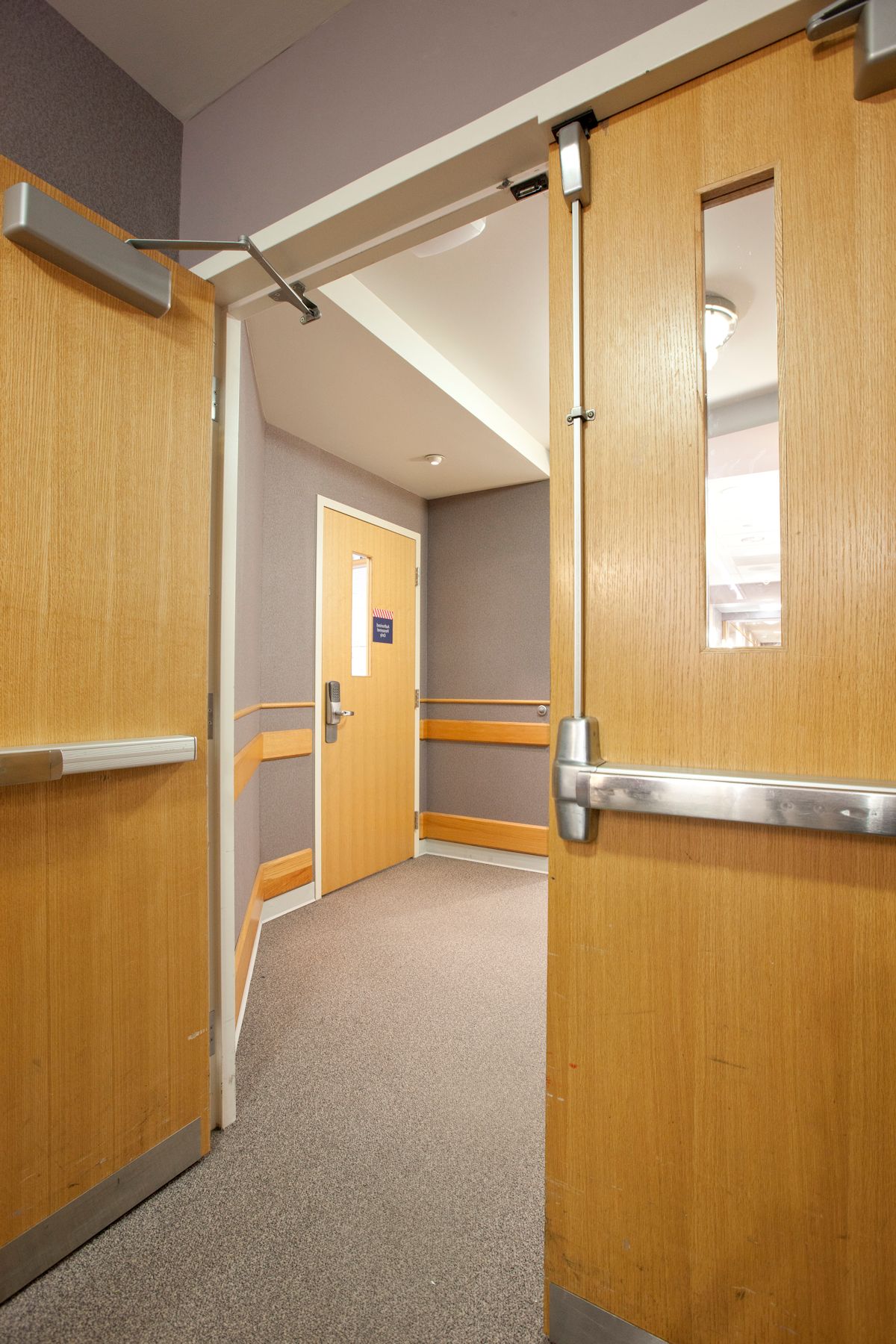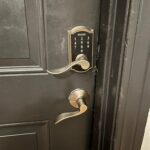 There has been quite a bit of discussion about this lately – fire doors installed where they are not required, listed components used on openings that are not fire door assemblies, products with different labels in the same assembly (for example, a 20-minute door in a 90-minute frame). I think the reason behind this increased focus is the enforcement of annual fire door inspections in health care facilities. I wrote about a possible conflict between the NFPA requirements and the Joint Commission’s procedures back in November, and I still haven’t received notice of a resolution.
There has been quite a bit of discussion about this lately – fire doors installed where they are not required, listed components used on openings that are not fire door assemblies, products with different labels in the same assembly (for example, a 20-minute door in a 90-minute frame). I think the reason behind this increased focus is the enforcement of annual fire door inspections in health care facilities. I wrote about a possible conflict between the NFPA requirements and the Joint Commission’s procedures back in November, and I still haven’t received notice of a resolution.
So we’ll keep chipping away at this issue until we are all clear on the intent of the model codes and standards. Today’s “chip” is the question of using fire exit hardware on a door that is not fire rated. Is this acceptable? Would the hardware or the entire assembly then have to be inspected annually?
Fire exit hardware is a type of panic hardware which is tested in accordance with UL 10C for use on fire doors, in addition to being listed to UL 305 for panic hardware. Typically, fire exit hardware would not be installed on a non-fire-rated door because fire exit hardware usually costs a bit more and does not include the dogging feature.
But what if a facility locksmith has fire exit hardware in stock and considers installing it on a non-fire-rated door? Or maybe a fire door is no longer needed in a specific location and the door label has been removed…can the fire exit hardware remain in place? As with so many questions like this, the codes and standards don’t specifically state the answer. Sometimes we just have to attempt to understand the intent of the codes and hope that the AHJ agrees.
I found something in the 2015 edition of NFPA 101 that may help us understand NFPA’s position on this issue. Even though a previous edition of NFPA 101 (the 2012 edition) is being enforced for most health care facilities, the language added in the 2015 edition is more of a clarification than an actual change.
This paragraph is included in the 2012 and 2015 editions of NFPA 101:
7.2.1.7.2* Only approved fire exit hardware shall be used on fire protection-rated door assemblies. New panic hardware and new fire exit hardware shall comply with ANSI/UL 305, Standard for Safety Panic Hardware, and ANSI/BHMA A156.3, Exit Devices.
This line was added in Annex A of the 2015 edition:
A .7.2.1.7.2 The presence of fire exit hardware on a door does not imply the door is required to be a fire protection–rated door.
The Annex A language indicates that it is possible to have fire exit hardware on a non-rated door. In my opinion, the language in NFPA 101 would prevent panic hardware without the UL 10C listing to be installed on a fire door assembly, but does NOT prevent fire exit hardware with the UL 10C listing to be installed on a non-fire-rated door.
I checked with NFPA staff to make sure I wasn’t missing something, and the staff member confirmed that neither NFPA 101 nor NFPA 80 prohibit the use of fire exit hardware on a non-fire-rated door, and also that the use of fire exit hardware would not prompt a need for annual inspection of the non-fire-rated assembly. The inspection requirements apply to opening protectives in locations where fire door assemblies are required. The installation of an individual listed component in a location that is not required to have an opening protective does not result in a need for annual inspections.
As always, I welcome your thoughts on this…whether you agree or disagree! This is my opinion, along with the NFPA staff opinion – an AHJ may or may not agree.
You need to login or register to bookmark/favorite this content.






The inspector will have to know what rating, if any, is currently required in every facility. You can’t go by the frame label either because some manufacturers such as Timely will use a 45 minute for both 45 and 20 and they will use a 90 minute for both a 60 and a 90. Another local shop we use will put an FM 90 minute on all rated frames.
I would say all provisions of panic hardware still apply
As in no other locking device
Yes needs to be maintained
I would say as long as you remove any UL labels off the hardware that it could be used. The device would then be a standard panic with a “No Dogging” option.
What about mortise or cylindrical locks? Don’t most have a UL stamp on the faceplate and they are used on Non Rated doors as normal.
I think we should remember that building codes represent a minimum requirement. I don’t advocate to design in excess with out thinking things through, but if the only deterant is cost, then no harm is done in terms of health, safety and welfare of occupants. The example of the fire rated panic on a non-structural door may provide energy savings or other positive attributes by not having a dogging feature.
Is it possible to identify a fire rated device if the UL tag has been removed? I know that fire rated devices don’t have dogging but I’ve ordered exit devices with ‘less dogging’ so that isn’t a 100% tell. Is there something inside the unit? Seem’s extreme but the mylar UL label are so easily removed.
They definitely need to be maintained because they serve life safety but I don’t believe they need to be inspected as part of the FDAI. It’s not a fire rated opening. Are we going to require that all inspectors look at the labeling on every panic device to make sure that they are not ALSO rated for fire? I would hope not.
NFPA 80 -2016, 6.4.4.2 states, “Fire Exit Hardware shall be installed only on fire doors bearing a label stating “Fire Door to be Equipped with Fire Exit Hardware”. The way this requirement is written, it will be interpreted that fire exit hardware may only be used on doors so labeled and not on any other doors, even ones that aren’t fire rated. If this isn’t the intent of 6.4.4.2, then I think the requirement needs to be re-written.
Hmmm…interesting point. But since NFPA 80 applies only to fire doors, there is nothing to direct someone to 80 when it’s a non-rated door. I will ask NFPA a follow-up question.
– Lori
We have been advised by a presenter of the FDAI training that it is not allowed basing it on the case that some fire exit hardware may have latches that are designed to sieze in high heat to secure the latches and contain the fire. One may argue at that temperature any hope of occupants exiting by means of a fire exit hardware being used as panic hardware on a non rated door would be a mute point.
Yes – by the time the hardware melts, the area is not survivable.
– Lori
The critical issue I could see would be whether internal damage from heat that was almost sufficient to make a unit seize up might cause it to fail in case of emergency, but without damage being sufficiently obvious as to ensure replacement. My guess would be that while it would be possible to deliberately construct a fire-rated exit system where that could happen under contrived circumstances, the likelihood of it happening in any realistic scenario would be essentially nil. If anything, the presence of a fire rating label which shows no sign of heat damage would tend to suggest that the latch had never been subjected to such heat.
I run into this all the time .The only difference between life saftey and fire safety hardware is its construction, the function remains the same. I hope however the inspector would check for proper labels on the devices used on labeled doors and frames,otherwise they become complacent and may overlook a door. I often deal with inspectors who believe that a UL label also implies fire rated .. and have to explain the difference… On a similar note I was on a job where the fire inspector demanded that all the doors that had door closers on them not be propped open or the arms disconnected . Even though none of these doors or frames were labeled or were in anyway part of a fire separation area . Again just because it had a UL label his thought was it must be rated. He did not even look at the door for a label ..
I have seen non dogging fire rated hardware used on exterior exit doors for security purposes so that the door cannot be left unlocked . Just saying …
You can also order panic hardware less dogging.
– Lori
I have had surveyors say it is rated, it must be inspected. Even if the opening is not rated. The discretion is entirely on the surveyor as the AHJ. You can argue and maybe push the point. But it is easier, just to remove the label, or use non-rated material, in my experiences.
When it comes to installing fire exit hardware, it can be hard to know what the right situation to use it is. Overall, it helps to check compliance and codes so that no matter what you do, your business can pass inspection.